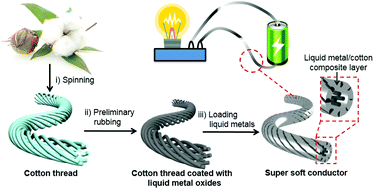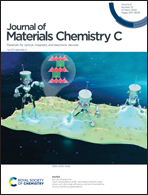Super soft conductors based on liquid metal/cotton composites†
Abstract
Soft conductors with high conductivity are highly desirable and valuable for the development of various flexible and wearable electronics. However, their preparation requires expensive equipment and tedious multi-step processes, resulting in high costs and limited applications. In this work, super soft conductors based on liquid metal/cotton composites were fabricated with cotton thread as the soft substrate and liquid metals as the conductive filler. The three-dimensional (3D) continuous liquid metal/cotton composites were formed on the surface layer of conductors by rubbing treatment, which has the advantages of easy operation, low cost and large-area production. The conductivity of the as-obtained conductor with a 96.8 wt% liquid metal content can reach up to 2.46 × 106 S m−1. Due to the super softness of cotton fibers and the fluid property of liquid metals, the conductor presented outstanding durability and stability against repeated external deformations (5000 folding tests) with the help of polydimethylsiloxane (PDMS), which acted as the protective layer. Furthermore, the soft conductor coated by PDMS was fabricated as a capacitive type of pressure sensor, which was integrated into sensing gloves and arrays to collect the pressure signals steadily and continuously.



 Please wait while we load your content...
Please wait while we load your content...